Jesse Ziegler | November 30, 2018
The Stage Is Set
We compare today’s most hard-core dual-sport motorcycles: Honda’s CRF450L, Beta’s 430 RR-S, KTM’s 500 EXC-F and Husqvarna’s FE 450.
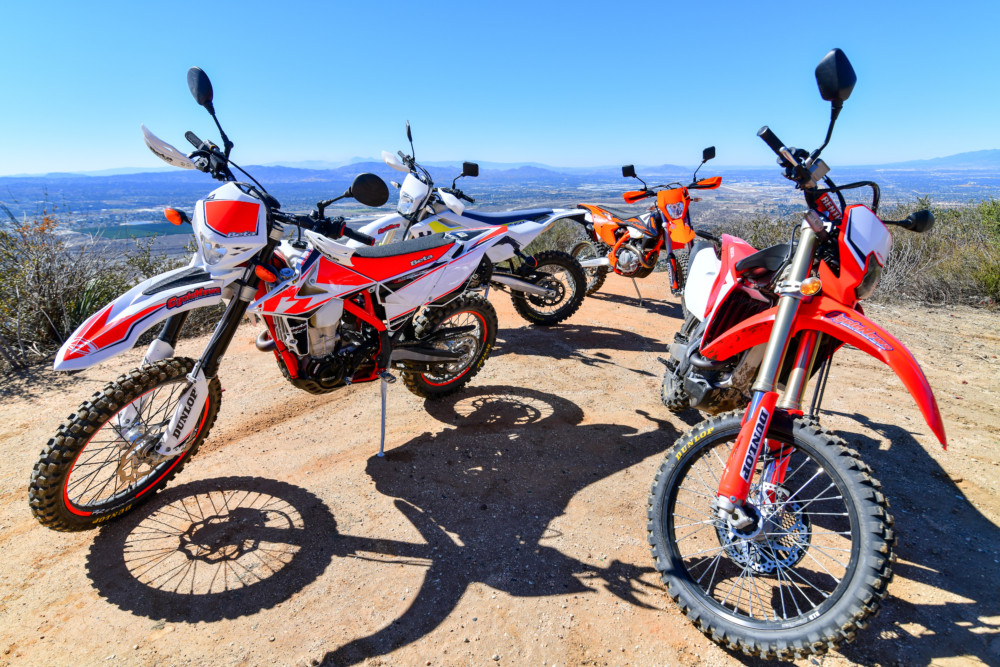
Dual-sport has changed. Once ruled by relatively inexpensive and softer-performing versions of dirt bike’s elite motocross and off-road racehorses, the dual-purpose bikes of the past were a fringe of off-road premium, not the mainstream of price or the tip-of-the-spear of performance we have today.
For the way most people want to, or will, use a dual-sport bike, the now aging street-legal performers of DR-Z, KLR, CRF, XR, XT and etc. acronyms of all displacements are perfectly fine. They go off-road just fine. They go on-road just fine. They are insanely dependable and durable, and you’ll tire of them before they tire out. They’re fine. Everything is fine. Like a marriage. It’s fine.
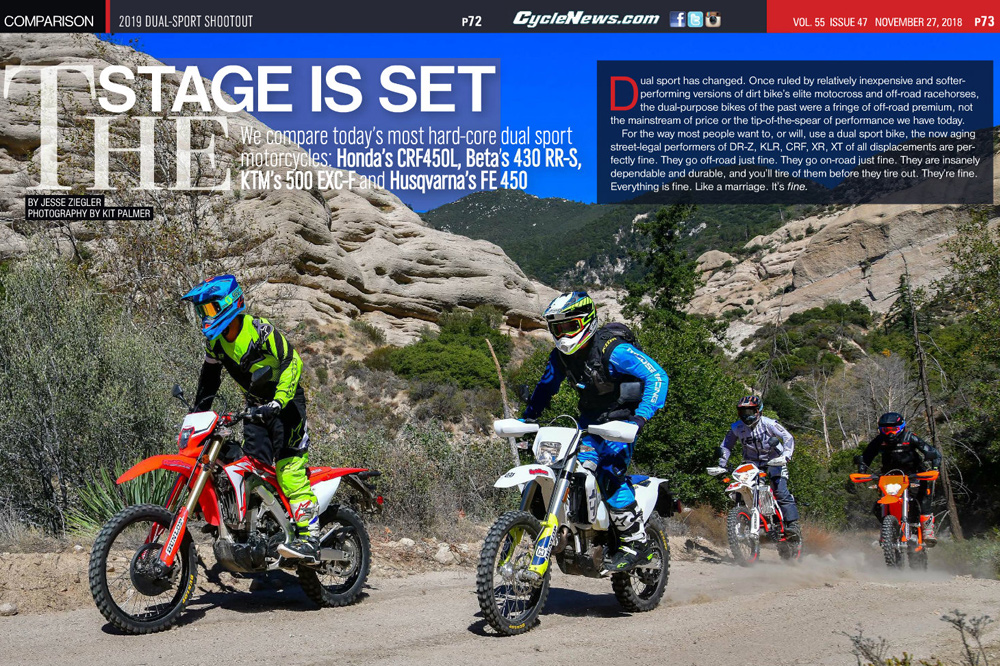
But the bikes in this comparison aren’t exactly like those bikes. These are bikes built on a different level. These are bikes with little attention paid to overall comfort. These are bikes intended to perform. Period.
Before you read further, and if you’re seriously considering the purchase of a dual-sport bike, it’s important to first look in the mirror and honestly ask yourself how you’re really going to use the bike and where you’re really going to ride it. If you’re considering a motorcycle to shuttle you around town or go riding on logging roads while chasing your kids, you should know that going in. There are a lot of less-expensive models on the dealership floor than these four prize ponies. There are plenty of bikes to scratch the dual-sport itch without dropping ten-grand-plus.
But, if you want to ride more aggressively off-road, stand up through technical trails, are okay with breaking turn signals off and scraping mirrors, fully expect to pick your bike up off the ground on occasion, feel like entering an off-road race or two every year and enjoy wheel-lofting through sand whoops once in a while, then you’re in the right spot here.
The Equipment
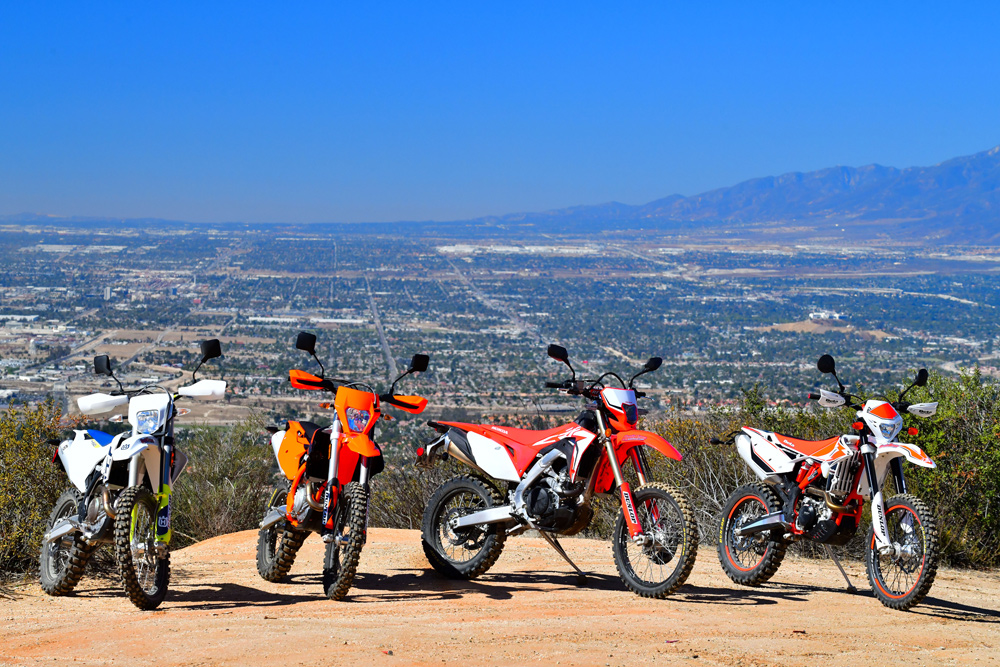 The (L-R) Husqvarna, KTM, Honda and Beta all in their element—far away from civilization.
The (L-R) Husqvarna, KTM, Honda and Beta all in their element—far away from civilization.
VIDEO | 2019 Dual Sport Comparison Test
2019 Honda CRF450L
The newest bike to this fleet of rides is Honda’s highly anticipated CRF450L. It comes years after people started screaming for street-legal CRF450Xs.
In a sense, the Honda CRF450L represents the future of dual-sport development. It’s the only bike in the test that incorporates a catalytic converter into the exhaust (it’s in the 13-pound muffler). It’s also obvious by looking at and riding the 450L that sound control, not just exhaust cleanliness, was a paramount developmental focus. Insulated plastic covers encapsulate the entire running gear and engine. Cushioned sprockets keep the chain from being noisy on rotation. The airbox is hidden deep inside the skeleton, far away from pesky sound meters that could pick up decibel-spiking intake rattle, gurgle or gulp as the CRF combusts.
Yes, the Honda is a compromised machine, in a sense, because of its meticulous development for—and careful final production specs to meet—street legality (and off-road) standards with nothing left to chance. It’s very Honda in this sense. And it is meeting future regulations that the United States might not even see.
Even as such, it puts traditional dual-sport performance to shame with modern off-road racing-inspired engine performance and suspension. Also nice is that this bike will likely remain mostly unchanged for the next decade, meaning the aftermarket will soon have the keys to make this into whatever people want. As a platform, the Honda is as solid as the Ride Red brand is in American dirt-bikers’ hearts.
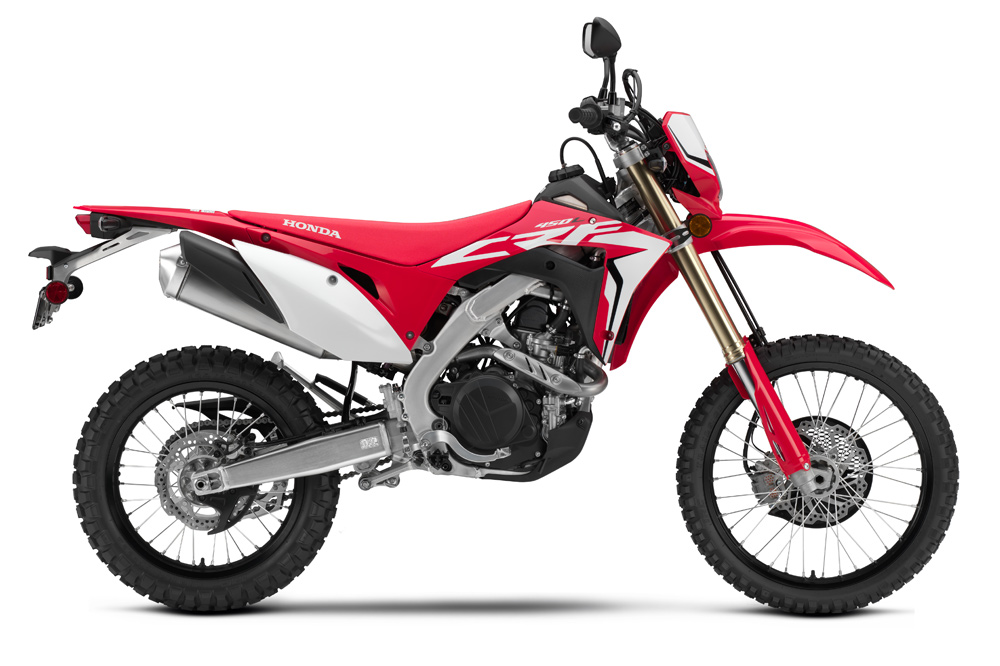
During our tests, the Honda got high marks for comfort and quality. It brings a package to the market that many Honda faithful will embrace. It feels like a Honda through and through. It provides warm, fuzzy consumer confidence. It’s safe.
Most universally liked about the Honda was its chassis and suspension performance when it came to hitting bumps head-on. The bike rides just the right line between plush compliance over small, sharp bumps and exceptional hold-up and resistance to harsh bottoming on hard hits and/or G-outs. It does this without harshness or surprise. As a platform nearly identical to the newly launched CRF450X, the CRF450L has the best suspension and chassis manners in this comparison when it comes to straight-up bump compliance. It was loved by all and proved the most stable bike in a straight line.
The Honda’s engine is deceptively good, but since it’s wrapped in a shield of noise control, it can trick you into thinking it’s sleepy. It is not. It has grunt that feels great when opened up. The engine pulls from idle to redline very smoothly. Its linear and strong, torquey delivery will impress you after you stop listening for power, and it will be really impressive if it’s the only bike you ride.
The Honda is likely not the fastest bike in the test, but none of our test riders knocked its power output more than saying it wasn’t very exciting. It’s sort of boring compared to the others, but it’s not lacking or weak. Its mellow delivery is a plus in almost all riding scenarios. From full stop to fifth-gear cruising, the engine will pull with the identical smooth and strong power up to the next gear. It’s a great engine for this class.
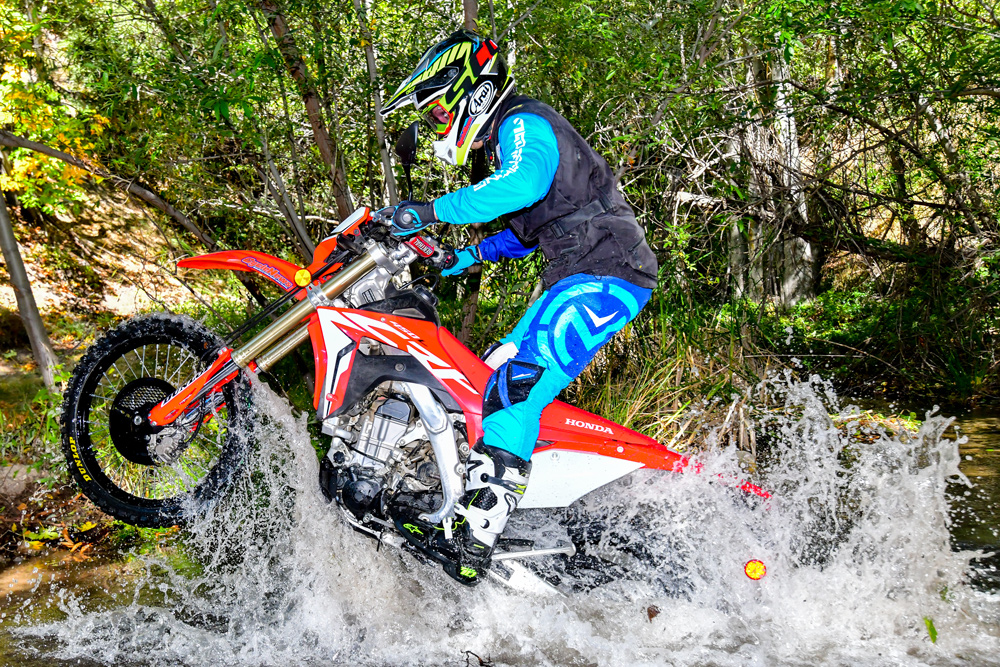 The CRF450L is quite capable of handling all of the elements that you might come encounter on the trail, despite not being the lightest bike in its class.
The CRF450L is quite capable of handling all of the elements that you might come encounter on the trail, despite not being the lightest bike in its class.
That smooth power delivery translates into the smoothest, most stable ride in the class on the road. It vibrates less than the other bikes in this test, but still buzzes more than the old-school bikes do. The 450L feels more planted on any road bigger than a two-track, as well.
Also getting high marks from our crew is the Honda’s superior LED lighting and turn-signal array. The headlight provides real-world usability that can actually hold its own on trails at night. It’s not immune to upgrades for night racing, but it’s way ahead of the bulb-lights on the other bikes. The turn signals, the Achilles heel of the European dual-sport field, proved indestructible and simply not in need of relocation or elimination. They are really good.
Following suit, the Honda’s instrument cluster is awesome. It provides easy, intuitive access to a wheel-driven odometer with two tripmeters as well as fuel-consumption data measuring actual fuel use. This calculates into what you’ve used, your mpg and your current fuel level. Brilliant.
The biggest weaknesses the Honda exhibited during our testing for almost all came down to the bike’s mass. Our test bike revealed 303 pounds on our scale with a full tank of gas (which is how we weighed all the bikes in this comparison), but it must be noted that the CRF450L came to us fitted with ultra heavy-duty inner tubes (left over from Honda’s press introduction in Washington); plus, we fitted all the bikes with heavier-than-stock Dunlop D606 DOT tires, and we also installed rim locks on our 450L, all adding to its 289 pounds that Honda claims is the weight of an off-the-showroom floor, fully fueled L.
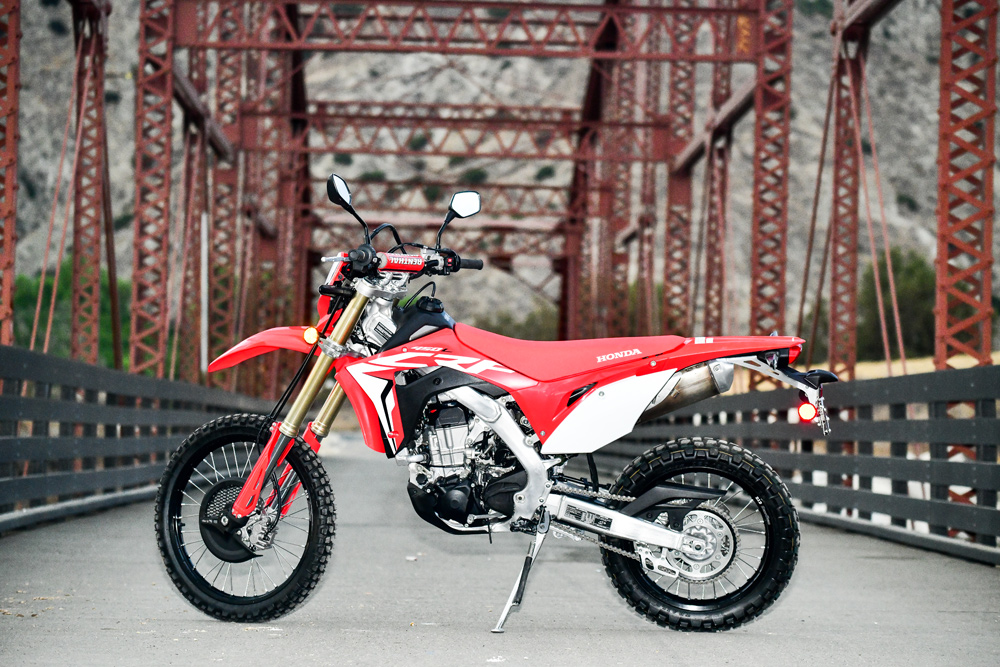 The Honda is probably the least offensive on the pavement of the four bikes we tested.
The Honda is probably the least offensive on the pavement of the four bikes we tested.
This bike feels as big and heavy as it is relative to the competition. It outweighs both Austrian bikes by approximately 40 pounds and the Beta by approximately 30 pounds. Unfortunately, the Honda will hold a half-gallon less fuel than its Austrian friends at this weight. It has the same fuel capacity as the Beta.
It’s impossible to ignore the weight disadvantage the Honda has when riding back to back with the lighter bikes in the class. The handling praise on straight-line bumps goes away pretty quickly when you get the 450L slowing and turning. Slowing and initiating turns on open roads isn’t done as precisely as the European bikes. This means the extra weight even shows up on fire roads. It takes significant body effort to move the 450L through the same terrain as roads get narrower and trails get tighter. And for truly technical off-road, the Honda did not shine as brightly as the Euro bikes.
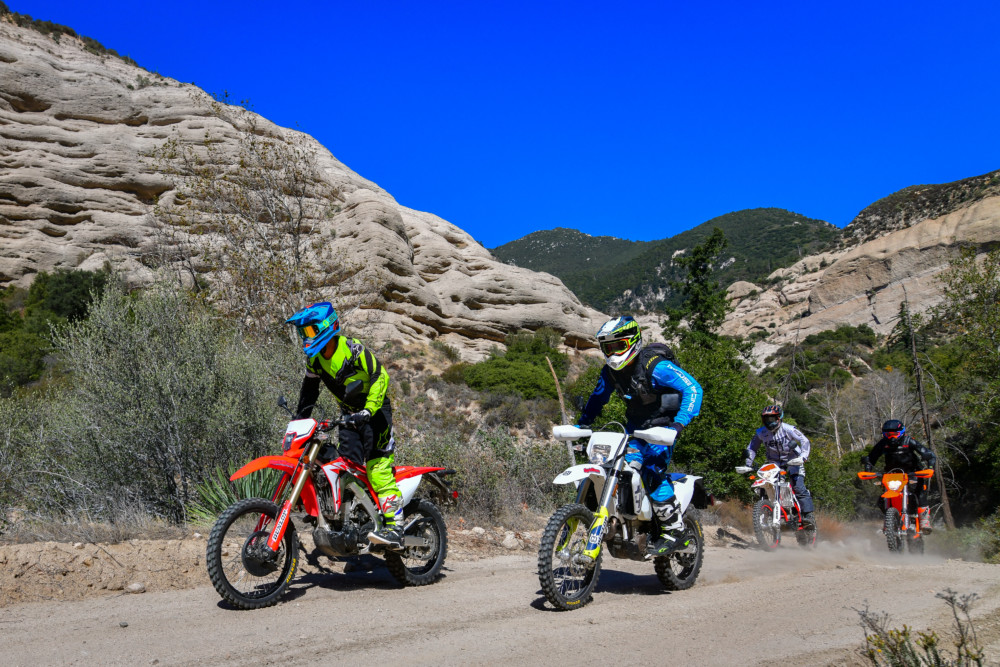
It hides its weight pretty well when going straight and while accelerating or hitting bumps (the additional pounds probably help its stability) but as trails get narrower or your turning arc gets tighter, the Honda becomes a bike out of its element.
The handlebar and fuel tank/headlight zone seems lazy and sluggish to input, and the rear end resists coming around naturally. Plus, both ends seem to be where the fight originates when reacting to technical-trail conditions or sandy terrain. The bike feels a little top heavy. As mentioned, the muffler alone weighs 13 pounds and it doesn’t get a lot higher on the chassis than that. Under the rear fender, there’s a full aluminum skeleton, as well, surely adding to the bulk and the top-heavy feel. High-quality electronics supporting headlight and bike computer function are also mounted up top.
Furthering the tighter terrain challenges for the 450L is its tendency to stall. These bikes are all running with relatively lean air/fuel mixtures and that can cause a pop-stall scenario. The Honda requires more careful clutch work to reduce this in rocky terrain. Still, it will happen.
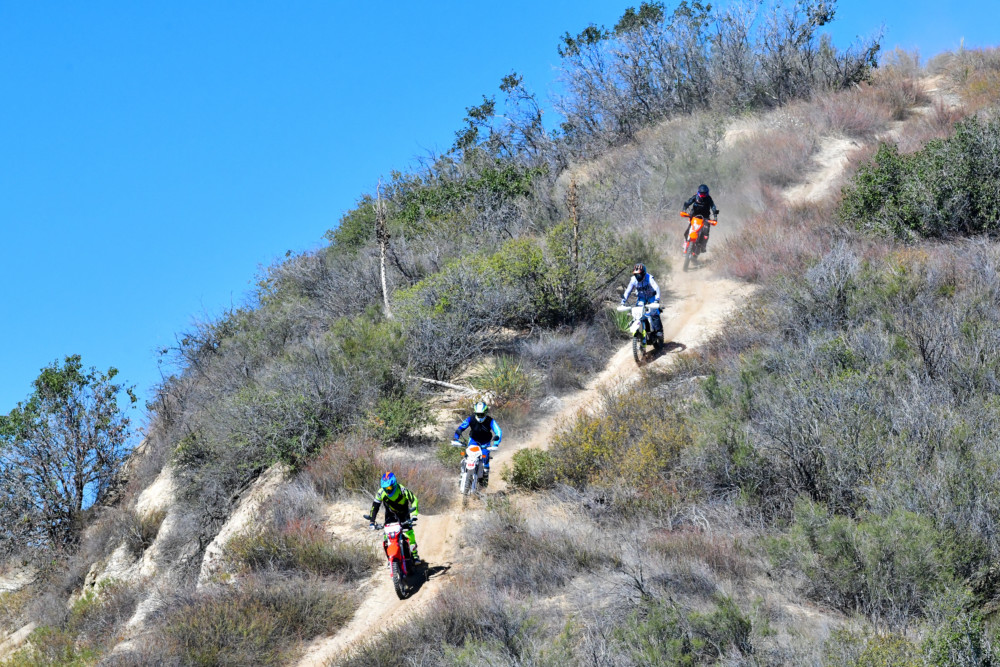
Finally, a few component choices and maintenance issues deserve comment. First, the bar bend on the 450L has a comfortable configuration for smaller riders and those sitting down. If and when you stand up, the bars will be in your lap a bit more than the more race-focused, straighter bars on the other bikes. Lastly, the Honda air-filter maintenance is a project. It’s two T-handles (10mm and 8mm) and a tight squeeze into a hole. Not having tool-less air filter access is a tough pill to swallow on a bike intended to ride on dirt most of its life.
The bottom line on the Honda CRF450L is this: It is a lot heavier than the current crop of competition and that definitely shows when the trail gets narrow or changes in direction are urgent. We expect aftermarket companies and parts swapping to help a lot here, but as a stock machine tested against other stock machines, all of our test riders ranked this bike at the bottom except for one. This tester intended to buy a 450L solely for “traditional” dual-sporting—cruising dirt roads and the occasional two-track. And even he admitted it’s not a lot better there than the others. His position is one of brand confidence more than anything. For all others, the slight advantage on the open road the Honda has over the rest didn’t improve its ranking.
Dual-sport isn’t about race weight and if you know you’re going to ride more two-track and fire roads at a pace that doesn’t require aggressive changes in direction or technical terrain domination, you’ll really love the bike. But, if you want to make it easier on yourself in technical terrain and over hill climbs or rock gardens, the other bikes in the test are a better choice with only slight compromises in ride comfort and handling. This is a great bike to ride a blend of easy trails, great dirt roads and two-track trails. It shows its weaknesses when pushed out of these elements.
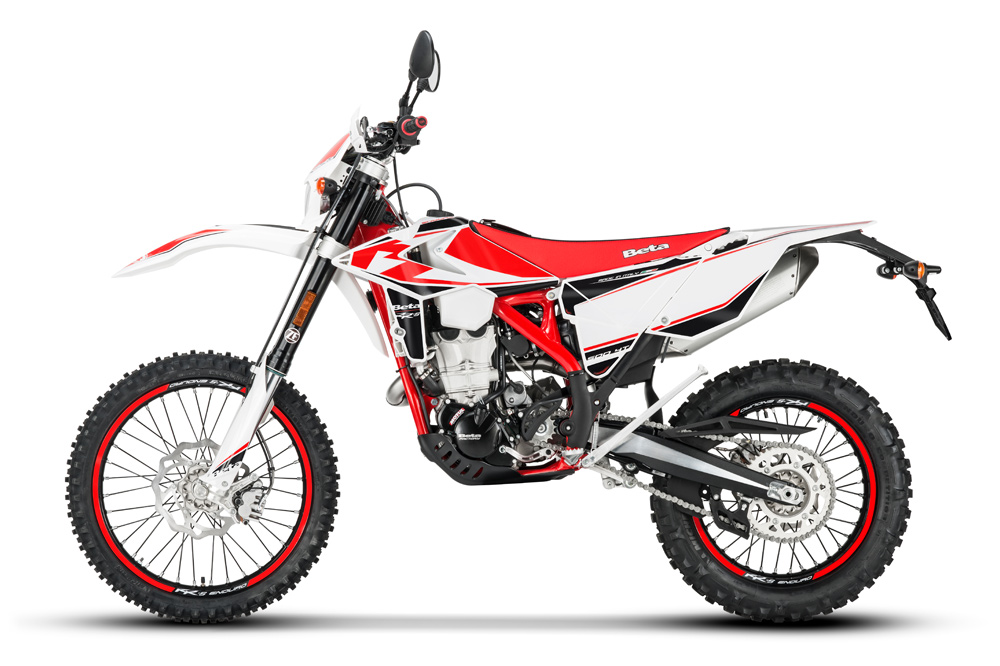
2019 Beta 430 RR-S
The sneaky Beta came into our comparison and blew everyone away. We’re not sure why we didn’t see it coming, because Beta’s dual-sport bikes have been impressive for years, but still, the smaller-displacement bike woke us up with an awesome engine and a fun ride that prefers the tight stuff.
Honestly, Beta is probably the least concerned with the long-term legality of their yearly models in this class. This bike could easily be labeled as the hooligan of the group, skirting the regulations tightly and loving it. They are certainly born from the European way of putting some gear on a race bike and calling it street legal. And it works for them, for now, so more power to them. We have favorable opinions of Beta’s off-road race machines and this fits in that area nicely with the added benefit of road legality.
With that comes a lot more noise. From the exhaust, especially, but also from the running gear. The exhaust note isn’t motocross obnoxious, by any means. It actually has a really great sound to it. But when you’re riding with more sound-conscious machines, it’s the loud one in the group, for sure.
A 430 is a weird displacement on paper. But man, does it rip. All of our test riders claimed it was the most fun to ride thanks to its quick-to-rev attitude and healthy low-end power. But what really shined was its inability to sign off on top. It simply takes off in the midrange and skyrockets into the upper rpm range with authority. It pulled third gear away from the Honda every day. And even while being outclassed by 80ccs to the big KTM 500 (510cc), the Beta still had the strongest top-end pull via the butt dynos and random drag races on duty.
It’s also a very well-balanced engine in terms of power. This bike seems to drive forward without as much aggression as the Austrians put into your hands and feet. The motor simply revs cleaner and faster without as much feedback, propelling you into dirt-bike goodness without the constant vibration and hot-rod atrophy the KTM and Husqvarna exhibit. It was nearly a match to the Honda in smoothness and lack of buzz all around, even on the pavement.
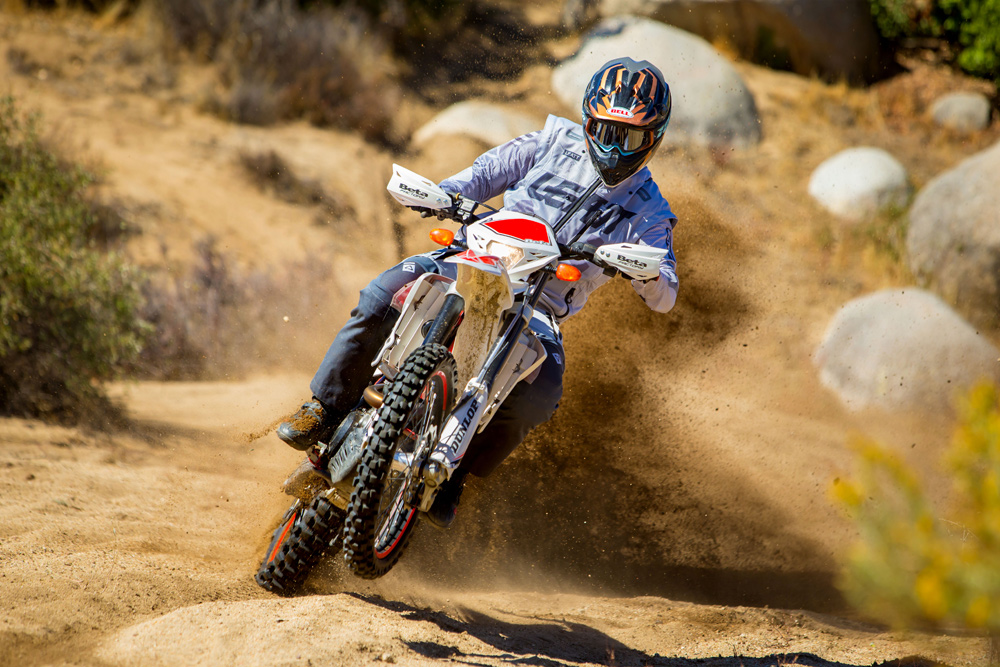 The Beta 430 RR-S is the sleeper bike of the group. It’s really good at just about anything. It might have the smallest displacement in this comparison but it’s still big on power.
The Beta 430 RR-S is the sleeper bike of the group. It’s really good at just about anything. It might have the smallest displacement in this comparison but it’s still big on power.
We spent a lot of time with its 500 RR-S brother in 2018 and really liked that bike’s ability to work well in tight terrain. It seems this Beta is in line with that. Its chassis is yearning for grass tracks and tighter terrain and we like the 430 best there. Out on the open roads and trails, the bike lost some of its shine and stability, even though the engine was still ready to party. If Beta can get the chassis and suspension to span the technical-to-wide-open range a little more, it’s going to be hard to beat.
Suspension setup on the Beta is the area where most of our test riders had issues. The bike seems to ride really low in the stroke on the shock and the front end feels loose with big push coming into corners. It’s almost like the spring rate is set from the factory for a pre-teen on the shock. We checked it and it was set at a normal adult sag. But the character of the bike just didn’t settle on the front wheel that well for our test riders at higher speeds. When dicing through trees or picking through rocks, this wasn’t an issue. The suspension is leaning on the soft side, as well, without the hold-up for big bumps that the Honda enjoys.
Another complaint came from the fuel range. This bike, like the Honda, has 2.1 gallons of fuel capacity. That’s good for about 60 miles before the light comes on the dash telling you to fuel up. Don’t push it past 70 or else you could be walking. It also gets the worst mileage of the group, consistently 10 mpg fewer than the others from ripping twisty roads to crawling through single-track. It’s thirsty. But the engine does like to party, so it makes sense it’s consuming more go-juice.
Finally, the last complaint on the Beta goes to the license-plate bracket and turn signals. Ours didn’t fall off in two days of bashing around, but they will soon. These components are certainly an afterthought.
 If you want to break from tradition, the Beta really is a great choice.
If you want to break from tradition, the Beta really is a great choice.
Without a doubt, this was our test riders’ favorite bike in tight single-track or if they just wanted to do drag races with a fun engine. The bike’s computer is a Trail Tech Voyager unit and its functionality is far superior to everything else in the test when it comes to navigation with full GPS. It also is the easiest display to read. The Beta has good mirrors, not amazing, but better than KTM and Husqvarna’s horrid pieces. You can access the air filter without tools just like a dirt biker should.
The bottom line on the Beta 430 RR-S: The Beta is certainly something different. And if that’s your bag, pack this one home. It’s a great engine in a chassis that just needs some fine-tuning to be usable everywhere we’d ride it. We do really wish it had more range via a larger fuel tank or more fuel-efficient engine. All of our test riders ranked this bike third out of four based mostly on the front-end’s lack of stability at speed. Also, your local Beta dealer availability will likely play a role in your buying decision. They’re not as plentiful as the other bikes here.
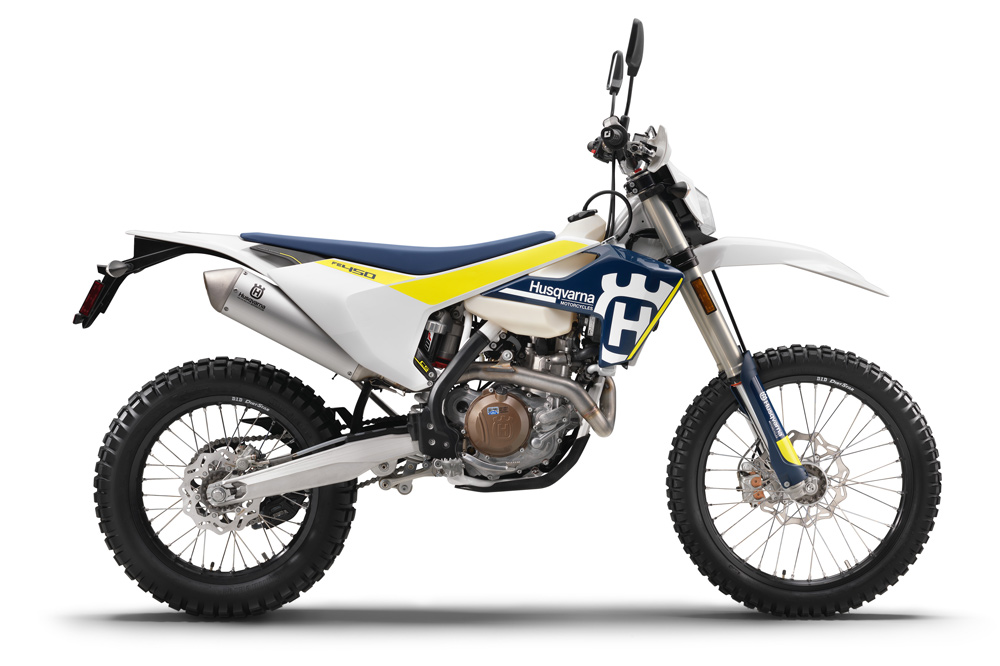
2019 Husqvarna FE 450
Husqvarna comes into the test with the only other 450-sized displacement machine. But it really couldn’t be much more different than the Honda CRF450L. The Husqvarna is a competition model carefully outfitted with the proper equipment to pass on-road regulation. It has racing seeping from its side panels and its ergonomics almost beg you to lay it into turns or let the rear end drift around corners. It’s a predictable chassis off-road with good suspension action across the board. It doesn’t enjoy the Honda’s full-spectrum of suspension performance, but it is performing right down the middle very well—providing aggressive riding hold-up and stability with slight compromises in initial bump compliance comfort.
Its parent brand, KTM, has the most experience in modifying an off-road platform into a dual-sport, and Husqvarna enjoys the benefits of that experience. It is, however, not a KTM clone.
There are enough unique features on the FE 450 that it really stands out in this test. For one, the chassis of the Husqvarna features a rear-shock linkage. The link-mounted suspension is the most polarizing difference in the off-road world between KTMs and Husqvarnas in this class. Most off-road traditionalists in our crew would rather have non-linkage, PDS rear suspension for the more technical terrain, as it’s less likely to hang up on obstacles and has fewer moving parts. It’s also lighter, overall than linkage and a lot of people love the PDS suspension action. The airbox and subframe on the Husqvarna is also different, but on these bikes, the performance difference isn’t too noticeable.
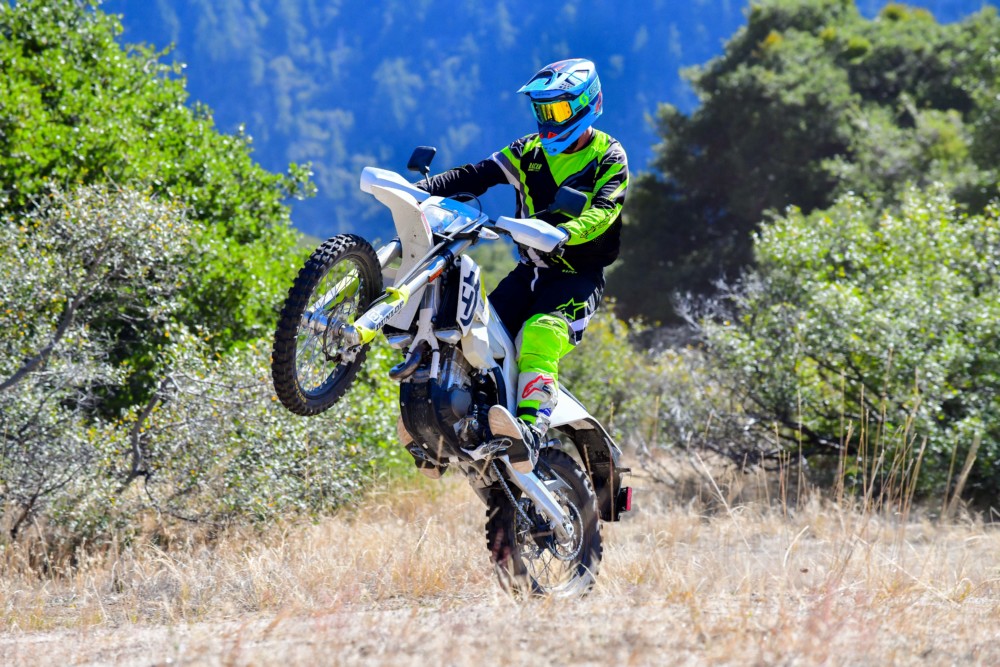 There isn’t much not to like about the Husqvarna FE450. It’s light enough for extracurricular activities, such as this.
There isn’t much not to like about the Husqvarna FE450. It’s light enough for extracurricular activities, such as this.
What is noticeable is the Husqvarna’s great handling character when being pushed out of most bike’s comfort zones. It thrives in technical terrain and holds its own on wide-open roads. The suspension is surprisingly good at race pace considering it also provides good comfort. The seat and bar position is right for standing up and getting dicey. The bike reacts to where you want it to go immediately and can stop and go across more conditions than anything else in this test. It’s lighter-feeling engine character even makes it feel more nimble than its orange brother.
Most rated the Husqvarna engine character right on par with the KTM 500, which is a huge compliment considering that the KTM is the big dog in this fight. The 450 revs a little quicker with a more spirited soul than the grunty five-hundo, and the displacement is a nice balance of grunt and rev. The engine is certainly livelier than the Honda, but it’s not significantly superior for normal dual-sporting and trail riding. It is certainly more fun to ride and is more exciting.
The Husqvarna FE 450 actually vibrates quite a bit less than the KTM 500 EXC on higher speed sections. It has a frequency that doesn’t annoy as much, for sure, but still provides great power. What it does lack in displacement is noticeable on the bottom only.
The Husqvarna also fuels well with zero stall issues in our test and it gets great fuel economy. Plus, it has a 90-mile range pretty easily thanks to holding extra fuel on board. (We’ve stretched stock bikes to 100 miles on a tank.) It doesn’t match the all-out performance of the Beta, but we feel the Husqvarna isn’t too far off the mark. Part of the difference here is sound. The Husqvarna has a quiet, strong tone from the intake to the exhaust where the Beta certainly sounds faster when it’s lofting the front wheel.
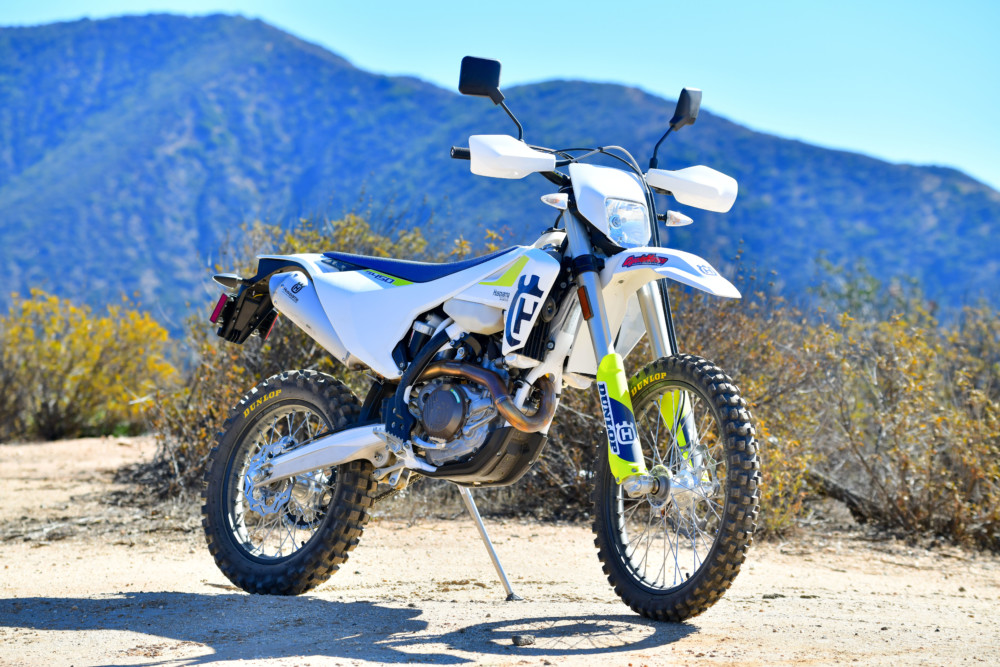 The Husqvarna just might be the prettiest dual sport bike on the trail.
The Husqvarna just might be the prettiest dual sport bike on the trail.
Husqvarna and KTM share superior braking performance and the Husqvarna’s Magura units seem to gain a bit of ground on KTM’s Brembos in the feel department. They are progressive and strong and fight for class leadership here. As far as the hydraulic clutch components, most test riders preferred the feel of KTM’s Brembo over the Magura on the Husqvarna.
In our ownership experience, it’s hard not to give praise to the Austrian brands’ maintenance and durability. Things like clutch plates and brake pads have long lifespans. The parts aren’t cheap to replace with OEM parts, but they just last a really long time. Maintenance tasks are straightforward and uncomplicated, air-filter access is tool-less, and the bikes can be absolutely thrashed in race situations in their completely stock forms.
Complaints for the Husqvarna come first from the vibration and comfort. It has one of the most uncomfortable seats in the test with the most aggressive seat cover material. It will wear you out, so to speak, and is hungry for an upgrade to a long-distance-worthy saddle. As mentioned, the Husqvarna doesn’t vibrate as much as the KTM, but that’s not giving it a lot of praise, as the KTM is the rowdiest ride of the bunch.
The last stack of complaints for the Husqvarna came at the expense of all the bolt-on bits to take it on the street. If you ride this bike with the stock license-plate bracket on, it will break off and leave your plate on the trail. The blinkers flex on bumps and get spit off by the rear tire. The front turn signals are fine, actually, but the light bulb in the headlight is ready for a modern upgrade, as well.
We actually had a switch assembly glitch on our test bike that progressively got worse. First, our horn stopped working (which is sad, because it’s a lot of fun to annoy your friends with a horn). Then the turn signals stopped reacting. The culprit was a loose wire in a connector in the wiring harness. Other than stuff falling off of bikes (like turn signals) this was the only glitch in our test.
The bottom line on the Husqvarna FE 450: This bike exhibits everything that modern performance dual-sports should be. It is light (only heavier than the KTM), it is nimble, it has triple-digit adventure range, it can pull all-day duty on fire roads and race-day stints on single-track with exceptional performance everywhere. Its only real weaknesses are an uncomfortable seat and less-than-stellar turn signals and plate bracket quality. It vibrates more than the Honda and Beta, but for most in our test, the tradeoff is well worth the better manners. This bike was very close in rank to the KTM 500 EXC from our testers, with most giving it a solid second place based mostly on KTM’s extra cc.
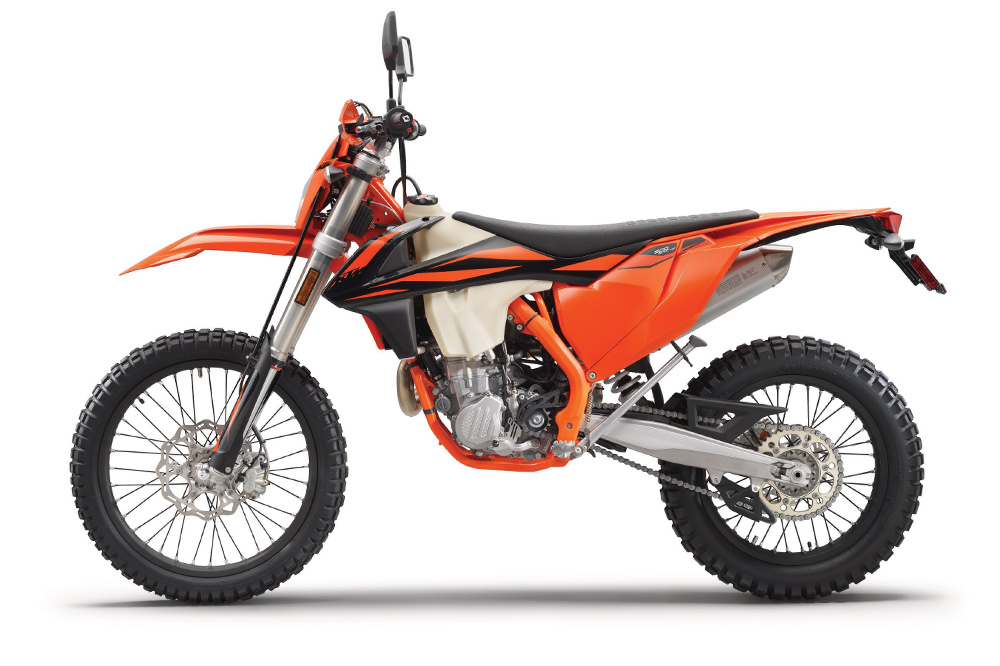
2019 KTM 500 EXC-F
The alpha dog of the modern performance dual-sport world is the KTM 500. On any given day, it is being used as a light-duty adventure wagon or a race-day mount and it performs remarkably well in both. It has the added benefit in this comparison of a lot more displacement (it’s actually 510cc). So, in straight-up performance, its no wonder people love its torque. It’s truly a third-gear bike in a lot of situations and, while it delivers some of the smoothest power out there, you can still tell it has a racehorse inside. It is never as docile as the Honda 450L.
But even its 450cc version, sold as a Six Days Edition, received similar praise and top-of-class rankings here. While those bikes weren’t official participants, we had them along for the ride and they are right there with this big dog.
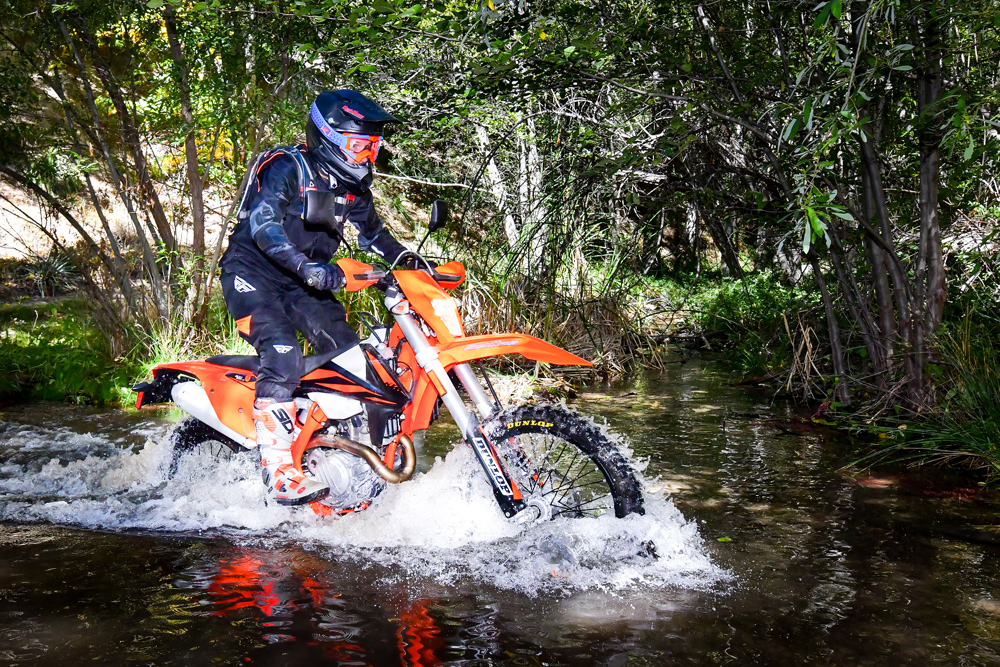 The KTM has been the dual-sport bike by which all others are compared for quite some time now, and probably still is. It’s a fun bike on all types of dirt roads and trails, and can be ridden aggressively or casually with equal amounts of fun.
The KTM has been the dual-sport bike by which all others are compared for quite some time now, and probably still is. It’s a fun bike on all types of dirt roads and trails, and can be ridden aggressively or casually with equal amounts of fun.
What makes the KTM platform so great is that it can check off all the boxes of what this class of dual-sport should do and then some. It compromises in a few places here and there, but they’re rarely deal breakers. From power output, delivery and consistency to chassis and suspension performance and tunability, the KTM still leads the charge in this class. Yes, it vibrates more than any other bike in this test. For that, it lost praise from some test riders on pavement stints and higher-speed roads. But all of them said it wouldn’t deter them from buying it, because they don’t really want to ride it there anyway. Those situations are a commute to trails, not the ride they’re intending to do.
Here, the Honda’s slight edge in less vibration was quickly discounted. But the Husqvarna’s slightly less buzz made it a worthy competitor. Beta, too, raised eyebrows with its smooth ride, but, in the end, the KTM has the handling prowess of the Husqvarna, with added torque. So it won more riders over for the overall.
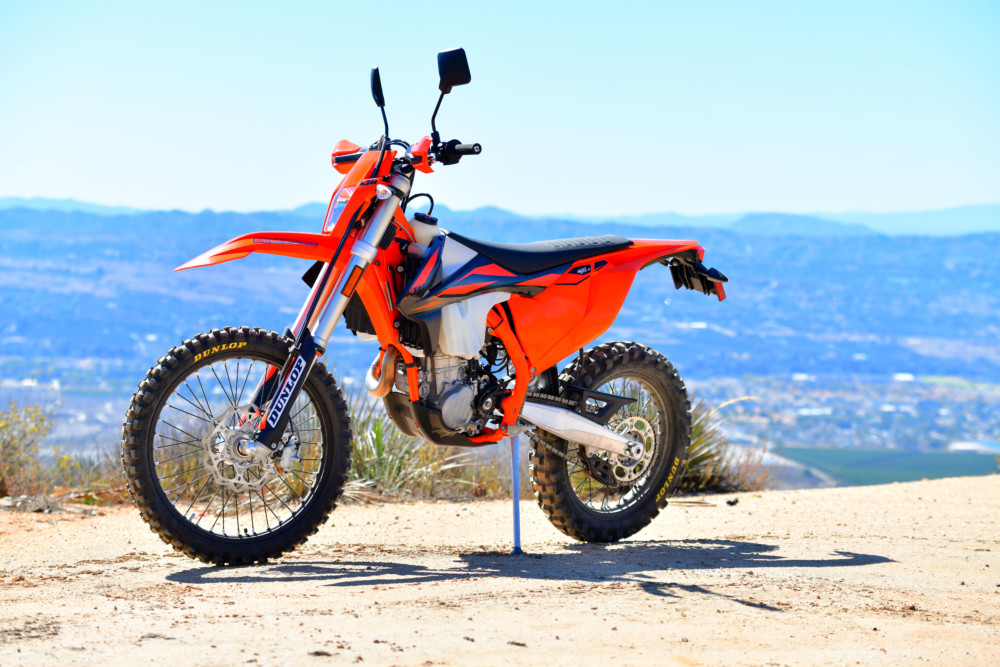 At $11,199, the KTM is the most expensive dual-sport bike out there, but that doesn’t seem to keep people away. These bikes are still flying off the shelves. What does that tell you about the KTM?
At $11,199, the KTM is the most expensive dual-sport bike out there, but that doesn’t seem to keep people away. These bikes are still flying off the shelves. What does that tell you about the KTM?
It is the lightest bike in the class, it shares the largest fuel capacity and the longest range. It incorporates easy maintenance tasks, the aftermarket is in full support of lighting options, luggage options and more. It can be comfortable racing Baja or going fishing and gives up very little to any of its competition on either end of the spectrum.
Plus, it’s a 500. Why not have the extra displacement in a dual-sport? It doesn’t come with many disadvantages.
The only complaints we had from testers on the KTM were about its vibration at high speeds and on the pavement, some suspension grumblings around the fork performance, and about the lackluster license-plate bracket that nearly immediately falls off. That’s it.
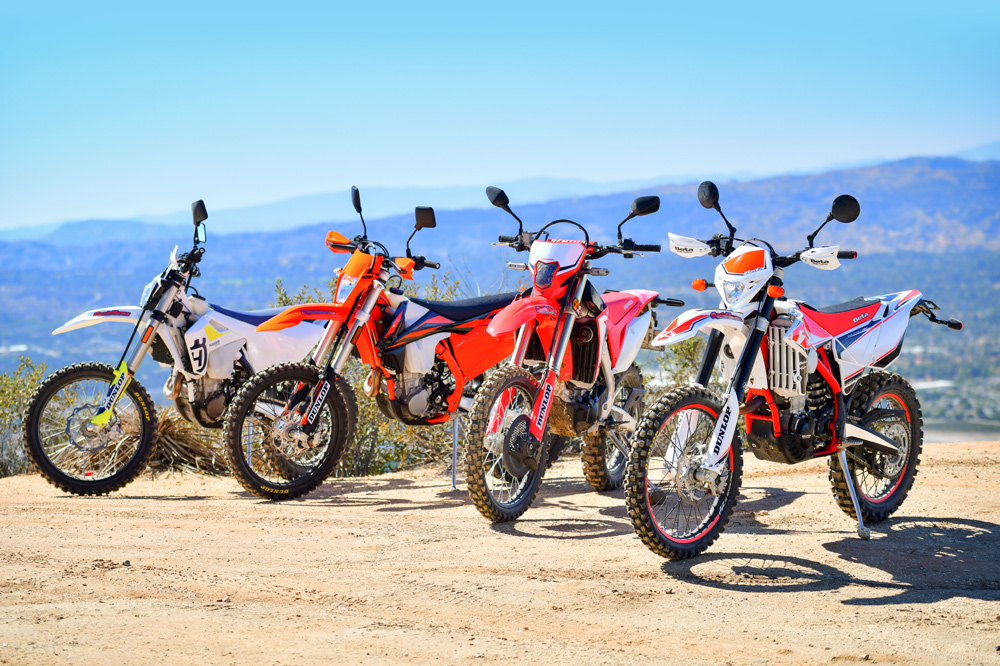
The bottom line on the KTM 500 EXC: If you want a performance dual-sport machine that has done it all for a decade, and done it exceptionally well, the KTM is the best choice. It can hang with the Honda on dirt roads only giving up a bit of comfort. It can rip with the sporty Beta in the tight stuff and not be off by much. It delivers the strongest power in a proven package with the most range. It does everything on the aggressive scale as well as the 450-sized bikes but with the added torque of an extra 60cc. It has a proven track record of durability and plenty of dealership and aftermarket support. This bike can be converted into a woods weapon or a rally racer. It defined the buy-one-bike market when it was introduced, and it still holds the throne. CN

| SPECIFICATIONS |
2019 Beta 430 RR-S ($10, 499) |
2019 Honda CRF450L ($10,399) |
2019 Husqvarna FE 450 ($11,099) |
2019 KTM 500 EXC-F ($11,199) |
| ENGINE: |
Liquid-cooled, 4-valve, DOHC, 4 stroke, single |
Liquid-cooled, 4-valve, Unicam, 4-stroke, single |
Liquid-cooled, 4-valve, SOHC, 4-stroke, single |
Liquid-cooled, 4-valve, SOHC, 4-stroke, single |
| BORE X STROKE: |
95 x 60.8mm |
96 x 62.1mm |
95 x 63.4mm |
95 x 72mm |
| DISPLACEMENT: |
431cc |
449cc |
450cc |
510.4cc |
| COMPRESSION RATIO: |
11.95:1 |
12.0:1 |
11.8:1 |
NA |
| IGNITION: |
Kokusan, DC-CDI w/ dual map selection |
DC-CDI |
NA |
NA |
| FUEL SYSTEM: |
42mm EFI |
46mm EFI |
42mm Keihin EFI |
42mm Keihin EFI |
| CLUTCH: |
Wet, multi-disc, hydraulic |
Wet, multi-disc |
Wet, multi-disc, hydraulic |
Wet, multi-disc, hydraulic |
| TRANSMISSION: |
6-speed |
6-speed |
6-speed |
6-speed |
| FRAME: |
Molybdenum steel |
Aluminum |
Molybdenum steel |
Molybdenum steel |
| FRONT SUSPENSION: |
38mm Sachs USD fork, fully adj. |
49mm Showa USD, fully adj. |
48mm WP Xplor, USD fork, fully adj. |
WP Xplor, USD fork, fully adj. |
| REAR SUSPENSION: |
Sachs, single shock, fully adj. |
Showa, single shock, fully adj. |
WP link-mounted single shock, fully adj. |
WP PDS, single shock, fully adj. |
| FRONT WHEEL TRAVEL: |
11.6 in. |
10.5 in. |
11.8 in. |
11.8 in. |
| REAR WHEEL TRAVEL: |
11.4 in. |
12.4 in. |
13.0 in. |
13.0 in. |
| FRONT BRAKE: |
260mm, single disc |
260mm, single disc |
260mm, single disc |
260mm, single disc |
| REAR BRAKE: |
240mm, single disc |
240mm, single disc |
220mm, single disc |
220mm, single disc |
| FRONT WHEEL: |
21 in. |
21 in. |
21 in. |
21 in. |
| REAR WHEEL: |
18 in. |
18 in. |
18 in. |
18 in. |
| TIRES: |
Michelin Enduro |
IRC GP21/22 |
Continental TKC 80 |
Continental TKC 80 |
| WHEELBASE: |
58.1 in. |
58.9 in. |
58.9 in. |
58.3 in. |
| SEAT HEIGHT: |
36.6 in. |
37.1 in. |
38.2 in. |
37.8 in. |
| GROUND CLEARANCE: |
12.6 in. |
12.4 in. |
14.6 in. |
NA |
| WEIGHT (wet): |
275 lbs. |
303 lbs. |
263 lbs. |
260.5 lbs. |
| FUEL CAPACITY: |
2.1 gal. |
2.01 gal. |
2.2 gal. |
2.3 gal. |